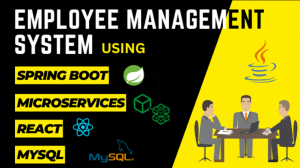In today's fast-paced business environment, effective employee management is crucial for the success of any organization. With the advancements in technology, companies are increasingly turning to digital solutions to streamline their employee management processes. One such solution is the Employee Management System, which combines the power of React JS, Spring Boot, MySQL, and microservices to create a robust and efficient system. In this article, we will explore the key features and benefits of this project.
The Employee Management System project is built using React JS, a popular JavaScript library for building user interfaces, and Spring Boot, a Java-based framework for developing enterprise-level applications. The database used in this project is MySQL, a widely-used open-source relational database management system. Additionally, the system is implemented using microservices architecture, which allows for the development of modular and scalable applications. One of the key features of the Employee Management System is its user-friendly interface built with React JS. React JS provides a component-based approach to building UI components, making it easier to develop and maintain the user interface.
The system offers a seamless and intuitive user experience, allowing employees and managers to access and interact with the system effortlessly. The Spring Boot framework is used to develop the backend services of the Employee Management System. It provides a comprehensive set of tools and features that simplify the development process. Spring Boot's dependency injection and inversion of control capabilities make it easy to integrate different components of the system and ensure smooth communication between them.
The use of MySQL as the database management system offers several advantages. MySQL is known for its reliability, scalability, and performance. It can handle large amounts of data efficiently and supports ACID (Atomicity, Consistency, Isolation, Durability) properties, ensuring data integrity and reliability. Additionally, MySQL is compatible with various platforms and can be easily integrated with other systems. The Employee Management System is implemented using microservices architecture, which brings several benefits to the project. Microservices enable the system to be divided into smaller, independent services, each responsible for a specific function. This modularity allows for easier maintenance and scalability of the system.
Each microservice can be developed, deployed, and scaled independently, making it easier to adapt to changing business needs. Furthermore, microservices promote loose coupling between components, making the system more resilient to failures and reducing the impact of any issues. The Employee Management System project includes various modules to support different aspects of employee management. These modules typically include employee information management, attendance tracking, leave management, performance evaluation, and salary management. Each module is implemented as a separate microservice, ensuring a high degree of flexibility and scalability.
With the Employee Management System, employees can easily access and update their personal information, view their attendance records, apply for leave, and track their performance metrics. Managers can efficiently manage their team's information, track attendance, evaluate performance, and process salary-related tasks. The system provides real-time updates and notifications, ensuring that employees and managers are always up to date with the latest information. In conclusion, the Employee Management System project, developed using React JS, Spring Boot, MySQL, and microservices, offers a comprehensive and efficient solution for managing employees in organizations.
The combination of these technologies provides a powerful, user-friendly interface, seamless communication between components, reliable data storage, and scalability. By implementing this system, organizations can streamline their employee management processes, improve productivity, and enhance overall operational efficiency. The Employee Management System project is a testament to the capabilities of modern technologies and their potential to transform traditional business processes. With the increasing demand for efficient employee management solutions, this project serves as a prime example of how organizations can leverage technology to stay ahead in the competitive business landscape.
https://www.codewithmurad.com/







